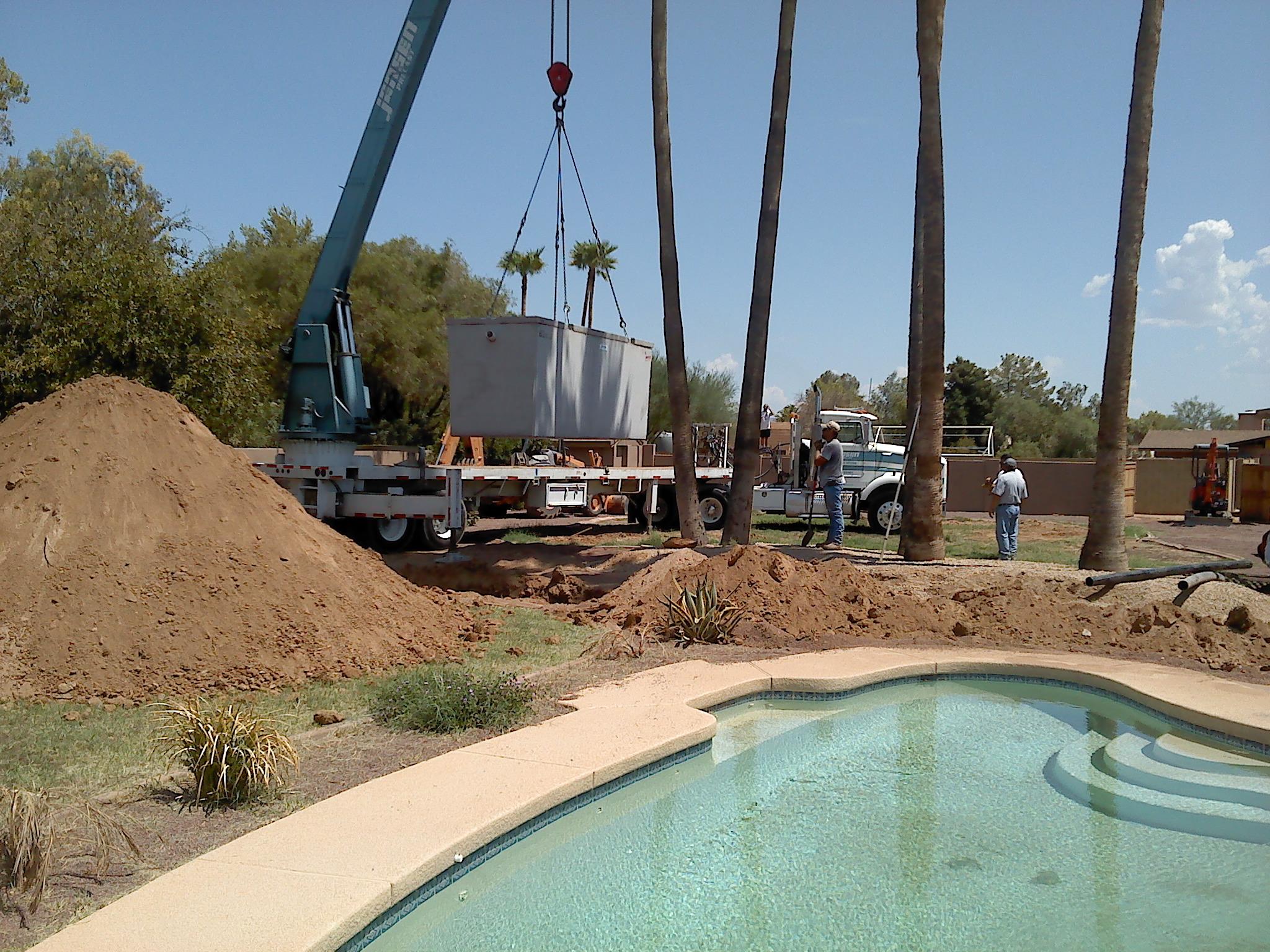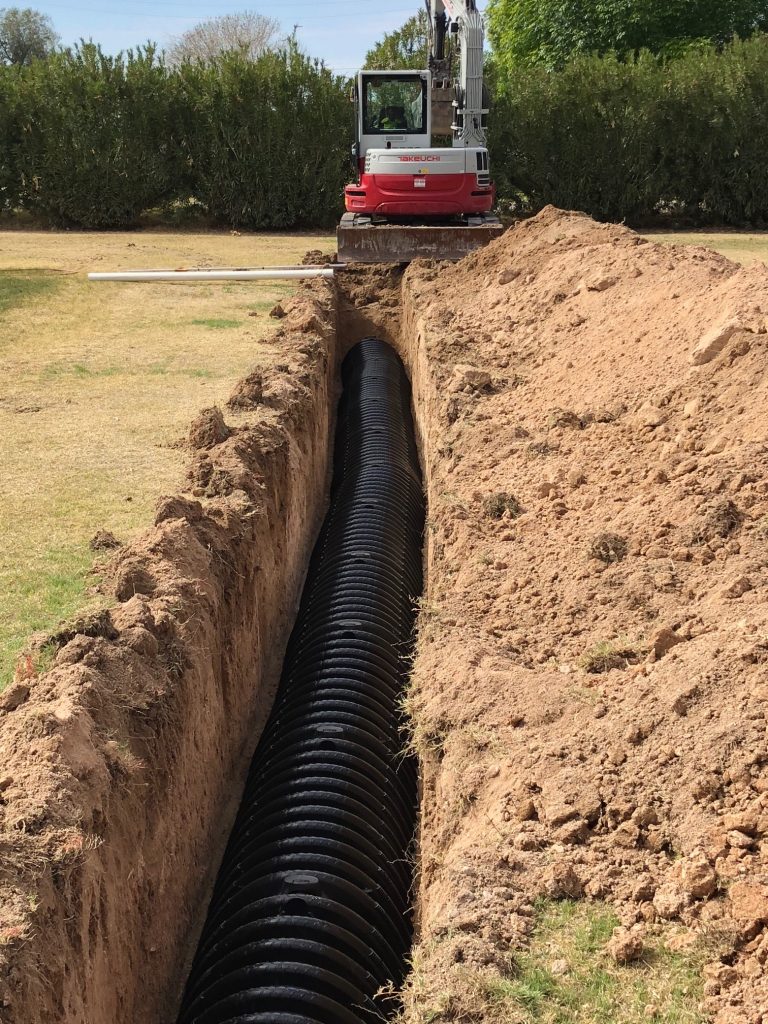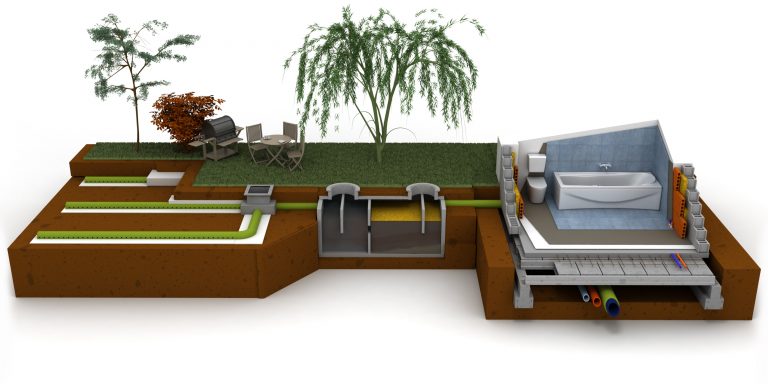Septic System Installation & Alterations

Free, on-site estimates Quick & Friendly Service That's what Priority Pumping is all about!
Are you building a brand-new home? Are you adding bedrooms on to your current home? Is your current septic system doomed and in need of a new septic system? Whatever the issue may be, Priority Pumping can help you with a FREE ESTIMATE!
Priority Pumping offers installations of conventional and advanced treatment septic systems for new construction homes, additions, remodels or total septic replacements due to aging or failing systems. We install both concrete and poly septic tanks ranging from 1000 gallons all the way up to 5000 gallons for commercial use.
Conventional septic systems are simple systems with a septic tank and a leach field. The effluent is treated in the leach field. An advanced treatment system or ATU (Aerobic Treatment Unit) is a more complex septic system where the effluent is treated either prior to entering the disposal field or with engineered products within the leach field.
All new septic tank installations require a permit from the local County Environmental Agency. Priority Pumping can help you obtain your septic tank installation permits with our full-service permitting program. After permitting is obtained, we will set a timeline to have your project completed as soon as possible.
We are your one-stop shop in the Phoenix area for all of your septic tank installation needs.
Priority Pumping offers support through all stages of the installation process.
Phase 1 Permitting
Site Evaluation and Soils Testing (perc testing) conducted on the same day!
Phase 2 Permitting
Application to Construct and Septic System Design - both conventional & advanced.
Installation Service
Full installation service for conventional and advanced treatment systems
Septic System Alterations
Replacing ONLY the septic tank or the disposal field,
permitting is required
Abandonment/ Sewer Connections
Abandonment of septic system to connect to public or private sewers.
Phase I Permit Application - Site And Soil Testing (perc test)
The Phase I permitting application includes completing a form provided by the County that includes the general overview of the property and the plans for the new septic system. This permitting phase requires a plot map with the proposed home site so that proper setback requirements can be met in determining the placement of the septic system. If you aren’t quite sure where you plan to put the home or if the testing is required for the bank to loan on the land, we will pick a good middle point and test there.
Our advice: if you aren’t submitting a plan to construct right away, just let us know. We’ll skip sending in phase 1 testing to the County for you. We’ll give you the report and you can submit the Phase 1 when you are ready to build and know the exact location of your home and out buildings.
Part of the Phase I permitting is to have a site and soil test conducted, interchangeably referred to as a perc test. This test is completed by digging three holes on the property. Two in the area of the proposed disposal field and one in the proposed reserve disposal field. Each hole is dug to the County requirements. (A full percolation test is done a bit differently than the site & soils, we’ll address those later).
We work together with a licensed sanitarian who will perform our site and soils evaluation the same day as the hole excavation. Once the holes are prepped our licensed sanitarian conduct a test determine the SOIL ABSORPTION RATE (otherwise known as the SAR). This is the rate at which the soil is able to absorb water that is introduced and explains the basic makeup of the soil characteristics. This number is used to help design the complexity of the disposal field that will be required to receive the effluent water from the septic tank once it is installed. The sanitarian will also provide a site analysis based upon proposed plot map to ensure that required setback measurements are possible with proposed home site.
After testing and observation are completed, we will back-fill the holes and we’re done! Our sanitarian will prepare the 6 page report required by the County and return it back to us in 3-5 business days. Once the report is returned with the SAR results, Phase II permitting can move forward.
If a site and soils tests end with unfavorable conditions for a regular conventional system, a full percolation test will need to be conducted. This test is a bit more involved and will be explained further at the test site if it becomes applicable to your situation. If your area of desired construction is already in an area popular for required ATU systems, we will alert you and plan accordingly for that test. CONVENTIONAL SYSTEMS DO NOT REQUIRE FULL PERC TESTS IN ARIZONA, so we always try to save our customers money by performing the site and soils first.
Phase II Permit Application and Septic System Design
This phase of the permitting process is where you submit your septic system design to the county for approval to construct. This phase includes selecting the proper septic tank size and designing a disposal method that is best based upon the SAR number that was provided in Phase I.
Selecting the proper septic tank size is done one of two ways and may actually consider both in close calculations. First, a current floor plan design will be required for this permitting phase to determine the number of bedrooms in the home and the number of plumbing fixtures that will be connected to the septic system. (this is includes garage sinks, barns, pool bathrooms, guest quarters, etc). Each plumbing fixture in the home is given a number based upon water usage required to operate each. An example of this would be a bathroom sink would represent 1 fixture where a toilet would represent 3 fixture-unit count; more usage, more water. All fixtures are added to a calculation sheet and a grand total of “fixtures” is notated. Also counted is the number of bedrooms in the home. Dens may also be counted as bedrooms in some cases.
With these two numbers we are able to properly identify the best tank size for the home’s predicted water usage. Sometimes when a new home is constructed, there are plans to build an addition or a garage/shop in the near future. These future additions can be taken into consideration when selecting a tank size. The system may appear to be a bit over-sized for the current home, but that eliminates the need for septic system re-construction down the road when the additional rooms or fixtures go over the permitting limit.
Check out the links here to help you understand the process.

In addition to selecting the correct septic tank size, the disposal field complexity must be calculated using the numbers from the bedroom/fixture count and the SAR number obtained in Phase I-Site and Soil testing. The most common conventional septic system disposal fields in Arizona are seepage pit(s), leach lines, or chamber systems. Each disposal field is quite different from the other and each are used for separate needs and applications. Each field also has it’s own special calculation to ensure that the depth or length of the fields is adequate to take the estimated effluent that is produced each day from the septic tank. If your soils test comes back requiring an advanced treatment unit, we can advise on the best system for your particular home, usage and the maintenance requirements.
Designing a septic system is a matter of acquiring the correct septic tank size and the correct disposal method and it’s individual complexity. Proper septic system design will ensure that you will have a system that will last you many years and perform it’s job properly. Once the system is designed and all of the documents are submitted correctly to the County, an Approval to Construct will be issued by the County. This is the green light needed to commence the installation process.
We offer complete permitting service for both phases of this process. Our service includes the completion of all applications, gathering of all required documents, complete scaled site plans, inspection scheduling and more. We’ve done all of the hard work in learning what is required to complete these permits as quickly as possible. Let us help you today!
Full Septic Installation Service
Once the Approval for Construction has been issued by the County, we can get your installation job scheduled to begin. Most systems can be installed within one – two week’s time, with county inspections. Our installation crew uses our own excavating equipment and we are fully licensed and insured to handle this big job. Our installation team has years of experience and are some of the nicest guys you’ll ever meet. Excavating is done to set the septic tank first and then the disposal field is excavating and installed. Upon completion of that, the two parts of the system are tied together with the proper plumbing and connections.
When the installation construction is completed, an inspection will be called into the respective County. A representative is usually on-site with 48 hours to inspect the final construction of the septic system before any portion of the system is covered up. Once we have received the tag to go ahead and cover, we will complete the project with precision and leave your septic area clean and presentable. And that’s it! You can now enjoy the use of your properly installed septic system. At the conclusion of your project, you will be given a permit package with all documentation included for your files and a maintenance manual for your system.
Septic System Alterations
It is important to know that there are two equally important components to a septic system: the septic tank and the disposal field. When one portion of the of septic system has failed and needs to be replaced, it is referred to as a septic system alteration. Common situations where an alteration may come into play could be these:
If the septic tank is eroded, deteriorated or cracked beyond repair and the disposal field is still performing well, you may only need to replace the septic tank.
If the disposal field is over-saturated or the structure is compromised beyond repair, yet the septic tank is functioning properly, you may only have to replace the disposal field.
If the septic tank and the disposal field are no longer working, the entire system must be abandoned and you will have to follow the new installation process.
Have questions? Give us a call! 602-601-5751 We want to help you!

There are few checklist items you have to consider when filing an Alterations Permit for the septic tank. If the home is still the same size (bedroom count) as the original system was permitted for, you can simply file an alterations permit to swap out like-for-like septic tanks. If additional bedrooms have been added without an increase in tank size, the County will make you account for those additional “bedrooms” and install a tank that is appropriate for the current structure of the home. We will also have to determine the exact disposal field method and confirm that the size and functionality of the disposal field through a Report of Inspection form.
Permitting for an alteration of a disposal field can sometimes be accomplished easily if there is a valid record of the original percolation test that was completed on the property at initial installation. This would allow us an SAR number to calculate the new field. However, if the system is older and no valid perc test is on file with the County, another percolation test may be required. Since this is such a case by case situation, Priority Pumping is happy to do a little research on your original permitting process to be able to give you the most accurate estimate for your alteration.
Septic System Abandonment & Sewer Connection
When a septic system fails and you must replace it, the current system will need to be properly abandoned. In Maricopa County, there is a required abandonment permit that must also be obtained in addition to the alteration or new installation septic permit. Septic tank abandonment is needed for a couple of different reasons:
- Sometimes only parts of the system need to be abandoned. This is called a septic system alteration and is discussed above. If you are only altering the tank or the field, you will only have to abandon the portion that you are replacing.
- If you are replacing the entire septic system, the entire system will need to be abandoned. This situation will occur if you are abandoning a complete failure system, upgrading to a larger system or choosing to connect to the city sewer.
The abandonment process can be achieved in two ways. We can slurry or dirt fill the septic tank and field or we can remove it in entirety. We will advise which option is best for your particular situation.
If you septic system fails and there is sewer in the vicinity of your home, your city guidelines may make connecting to the sewer a must!
Maricopa & Pinal County’s are growing at a rapid pace. Can you believe Maricopa County has been the fastest growing County in the nation for three years in a row! There are many capital improvement projects going on throughout all of the Phoenix metro and surrounding cities. Some of these capital improvement projects include running new sewer lines through older septic neighborhoods. Although many areas do not make it mandatory to connect at the time the sewer is placed, many homeowners choose to do so or are forced to once their septic system fails.
Priority Pumping can help you with this process. We are knowledgeable in permitting and will help you navigate your way through the paperwork and city processes in order to be able to tap into the city sewer system. The old septic system is abandoned and the plumbing is re-routed in order to connect to the sewer. Call us today to learn more 602-601-5751.